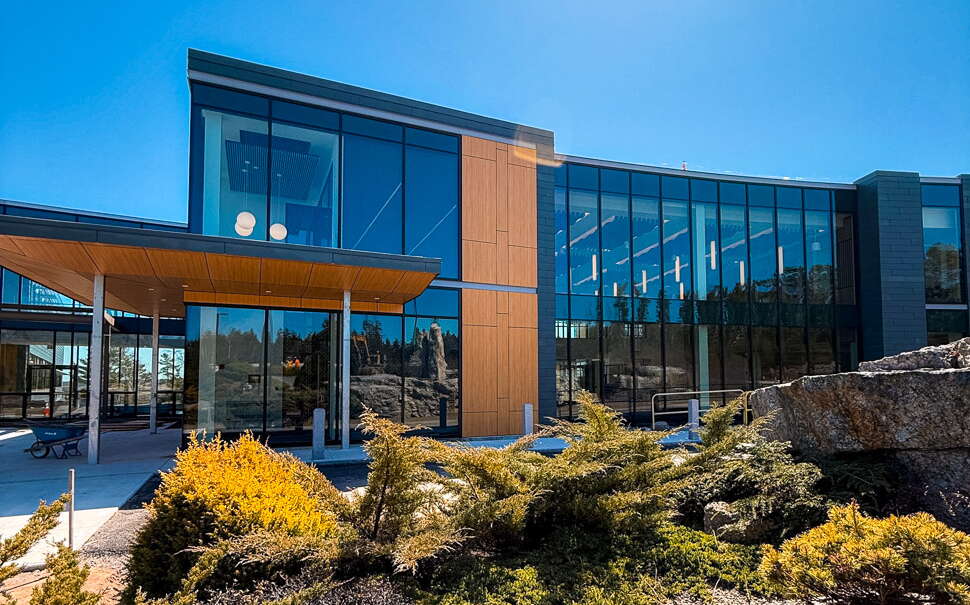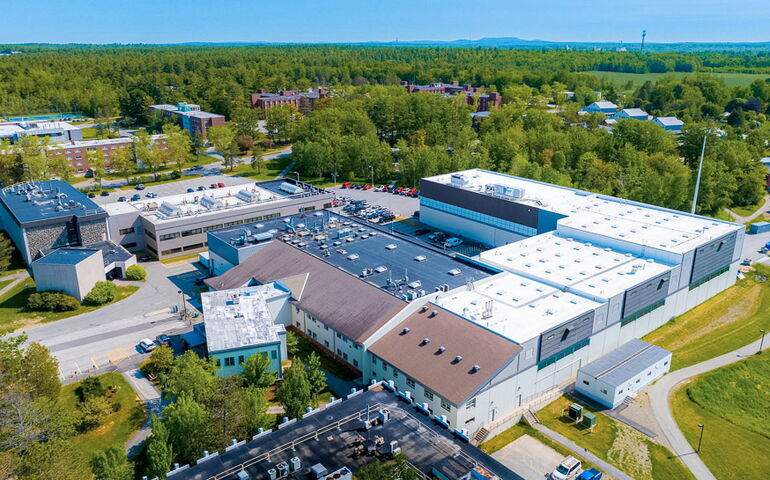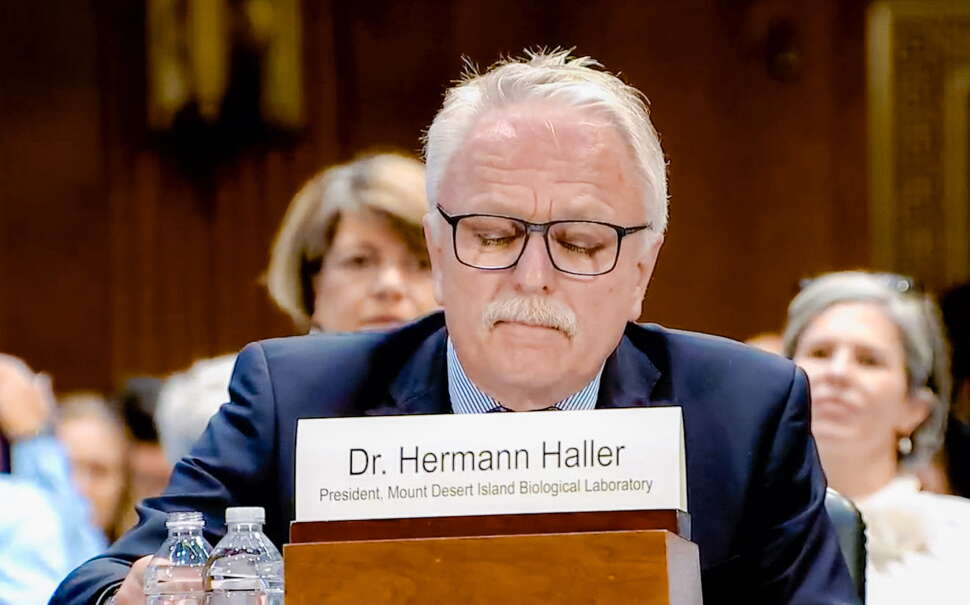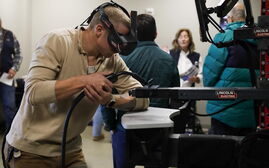
Processing Your Payment
Please do not leave this page until complete. This can take a few moments.
- News
-
Editions
View Digital Editions
Biweekly Issues
- December 15, 2025
- December 1, 2025
- Nov. 17, 2025
- November 03, 2025
- October 20, 2025
- October 6, 2025
- + More
Special Editions
- Lists
- Viewpoints
-
Our Events
Event Info
Award Honorees
- Calendar
- Biz Marketplace
Funding cuts weigh on research projects across Maine
 Photo / Courtesy of University Of Maine
Staffing at the University of Maine composites lab in Orono has been cut.
Photo / Courtesy of University Of Maine
Staffing at the University of Maine composites lab in Orono has been cut.
The whiplash effect from funding reversals is consistent with a lot of policy decisions coming out of Washington, but ever since Gov. Janet Mills’ public dust-up with President Donald Trump in April, the University of Maine and other research institutions in the state have seen funding cuts affecting a wide swath of programs.
By April, nearly $91 million had been frozen from six grant programs at the Maine Center for Disease Control and Prevention and the Office of Behavioral Health, according to Maine Department of Health and Human Services Commissioner Sara Gagné-Holmes.
Some cuts have since been paused by legal action.
At the University of Maine System, spokeswoman Samantha Warren said earlier this month that 16 awards had been restored that the federal government had previously cut, mostly at UMaine. The balance remaining on those reversed awards is $3.5 million.
Bigelow opens ocean education lab thanks in part to philanthropic support
In some cases, state and philanthropic support has helped fund the gaps.
At Bigelow Labs in East Boothbay, $5 million in National Science Foundation grants that had been recommended has been on hold. But an $8 million gift from the Harold Alfond Foundation helped fund the building of the $31 million Center for Ocean Education and Innovation, which is named for the Maine benefactor, and opened in June.

Bigelow Labs is an independent, nonprofit research institute with a focus on global ocean health.The new 25,000-square-foot addition is expected to broaden the lab’s business innovation, applied research and education programs, and constitutes a 40% increase in the laboratory’s footprint.
In addition to the Alfond Foundation grant, the project benefitted from $13 million in other philanthropic gifts along with a $12 million grant from the National Institute of Standards and Technology. A $2 million maintenance endowment from an anonymous donor will support capital repairs and equipment replacement.
MDI BioLab fears cuts to NIH funding
Hermann Haller, president of Mount Desert Island Biological Laboratory, testified in May at a U.S. Senate Appropriations Committee hearing in Washington, about his concerns that a proposed cap in funding from the National Institutes of Health could drastically affect biomedical research.
The hearing was led by U.S. Sens. Susan Collins, R-Maine, and Patty Murray, D-Washington, the committee’s chair and vice chair.

Haller explained that independent research institutions like Bar Harbor’s MDI Bio Lab, don’t have large endowments or tuition revenues, but depend on indirect cost reimbursements for part of their funding.
The NIH was proposing to cap indirect costs, which include laboratory space, services and supplies, at 15%, which Haller told the committee endangers his lab’s work to promote “life-saving research and biomedical breakthroughs.”
Haller said NIH’s proposed cap would decrease a typical year’s grant support by 27% and would slow, and potentially end, some biomedical research projects and limit training opportunities for college students and early-career scientists.
In Maine, NIH grants and contracts support 1,468 jobs and $286 million in economic activity.
In 2024, MDI Biological Laboratory NIH grants included $19.4 million to renew and expand a network of research and higher education institutions called the Maine IDeA Network of Biomedical Research Excellence, and a $6 million funding renewal related to its light microscopy facility.
In April, Maine had joined 21 other states in a lawsuit against the Trump administration’s attempt to cut NIH funding. The suit was filed in U.S. District Court for Massachusetts and is pending.
UMaine Composites Lab funding cuts lead to layoffs
The University of Maine Advanced Structures and Composites Center on the Orono campus has laid off nine employees so far, in the wake of federal funding cuts handed down in June.
The layoffs included engineers, scientists and technicians. In a notice to employees, the center’s leaders wrote that unanticipated pauses and delays in funding have required projects to be slowed or rescoped, necessitating the staffing reductions.
“Our leading work in composite materials, advanced manufacturing, the GEM [Green Engineering and Materials] Factory of the Future, national defense, boatbuilding, transportation, housing and energy addresses pressing technical and societal needs,” the statement read.
“Looking ahead, we will continue to seek new research opportunities that build on these tremendous strengths and further diversify our funding portfolio.”

Warren said more than 85% of ASCC’s funding comes from grants and contracts with the federal government, but funding diversification is now a priority. The floating wind turbine project is one example where the university is casting a wider funding net.
The U.S. Department of Energy in April suspended three awards to ASCC, totaling $15.8 million, with $3.3 million remaining to be paid out for the floating wind turbine project. That suspension notice came just hours after the 375-ton concrete floating hull had been towed to Searsport, in preparation for installation in Penobscot Bay off of Castine.
Warren said the project will continue, in a reduced capacity. “With the remaining $3.3 million in previously pledged federal funds currently unavailable, UMaine has reduced the scope of the research and is moving the project forward using existing resources, including industry partnership revenue and state funds.”
The floating platform was installed off the coast of Castine on May 15 as planned, and Warren said it will remain there for 18 months to collect real-time data. “Without the expected funding,” she emphasized, “researchers will be limited in their ability to analyze the findings and develop a commercialization plan for this revolutionary technology, which has industrial applications well beyond ocean energy.”
Collins said in a statement at the time, “The new administration clearly has different energy priorities than the previous administration, and this will have a direct impact on research funding sources.
“That will mean that if the state government wants to continue some of this work, it will have to provide more of the funding than it has in the past.”
Sea Grant program staved off funding cuts
In February, the U.S. Department of Commerce’s National Oceanic and Atmospheric Administration notified UMaine that it was immediately terminating a four-year $4.5 million award for the Sea Grant program, with three years remaining.
Then two months later, the university was notified that the NOAA was reversing the decision, an apparent result of Collins’ intervention on that funding cut.
Money was released for the upcoming year, but allocations for the two additional years are contingent upon future appropriations by Congress.
Maine’s Sea Grant supports challenges facing Maine’s coastal economies through research, education and programming. The Orono-based project is one of 34 nationwide and was the only one that had funding eliminated.
The program has more than 700 partnerships with businesses, researchers, community organizations and local and county governments and supports hundreds of jobs. In 2023, programs and services supported by Maine Sea Grant generated $15 of economic activity in the state for every federal dollar, for a total impact of $23.5 million.
“We are deeply appreciative of Sen. Collins’ leadership and relentless advocacy on behalf of Maine Sea Grant and the hard-working Mainers it has long served,” Joan Ferrini-Mundy, UMaine’s president, said at the time.
“We look forward to continuing our longstanding partnership with the U.S. Department of Commerce and our state’s coastal communities to promote resilient local jobs and opportunities and a globally competitive marine economy through research-informed innovation.”
PFAS research funding gets cut, then restored
The U.S. Environmental Protection Agency on June 6 notified UMaine that it was restoring the full $1.6 million grant to researchers working to reduce the risks of forever chemicals, known as PFAS.
The university had received a termination notice in May, with $1.4 million of the award still outstanding. “The objectives of the award are no longer consistent with EPA funding priorities,” was the only explanation given.
PFAS — per- and polyfluoroalkyl substances — were first found to be present in farm fields in the state in 2016, and were linked to the practice of using sludge from municipal wastewater treatment plants as an inexpensive fertilizer. It was later discovered that an estimated 90 Maine farms were affected.
The practice was banned in Maine in 2022 and the state created a $60 million fund, administered by the Maine Department of Agriculture, Conservation and Forestry, to assist affected farmers and support research.
PFAS are blamed for a range of health issues, including decreased vaccine response, higher cholesterol levels, impaired infant and fetal growth, increased risk of some cancers and pregnancy complications such as hypertension and pre-eclampsia.
Warren said the newly restored federal funding to UMaine will complement a recent $499,995 grant from the Department of Agriculture, Conservation and Forestry to study how PFAS compounds in soil can make their way into human food systems.
UMaine has been granted a total of $3 million this year from the state DCAF fund for PFAS research.
Mainebiz web partners
Related Content

The Giving Guide
The Giving Guide helps nonprofits have the opportunity to showcase and differentiate their organizations so that businesses better understand how they can contribute to a nonprofit’s mission and work.
Learn More
Work for ME
Work for ME is a workforce development tool to help Maine’s employers target Maine’s emerging workforce. Work for ME highlights each industry, its impact on Maine’s economy, the jobs available to entry-level workers, the training and education needed to get a career started.
Learn More
Groundbreaking Maine
Whether you’re a developer, financer, architect, or industry enthusiast, Groundbreaking Maine is crafted to be your go-to source for valuable insights in Maine’s real estate and construction community.
Learn more-
The Giving Guide
The Giving Guide helps nonprofits have the opportunity to showcase and differentiate their organizations so that businesses better understand how they can contribute to a nonprofit’s mission and work.
-
Work for ME
Work for ME is a workforce development tool to help Maine’s employers target Maine’s emerging workforce. Work for ME highlights each industry, its impact on Maine’s economy, the jobs available to entry-level workers, the training and education needed to get a career started.
-
Groundbreaking Maine
Whether you’re a developer, financer, architect, or industry enthusiast, Groundbreaking Maine is crafted to be your go-to source for valuable insights in Maine’s real estate and construction community.
ABOUT
NEW ENGLAND BUSINESS MEDIA SITES
No articles left
Get access now
In order to use this feature, we need some information from you. You can also login or register for a free account.
By clicking submit you are agreeing to our cookie usage and Privacy Policy
Already have an account? Login
Already have an account? Login
Want to create an account? Register
Get access now
In order to use this feature, we need some information from you. You can also login or register for a free account.
By clicking submit you are agreeing to our cookie usage and Privacy Policy
Already have an account? Login
Already have an account? Login
Want to create an account? Register










0 Comments